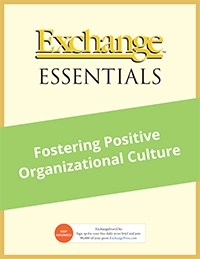ExchangeEveryDay Past Issues
 << Previous Issue
| View Past Issues | | Next Issue >>
<< Previous Issue
| View Past Issues | | Next Issue >> -Maria Montessori
Writing in the Harvard Business Review, Deborah Mills-Scofield declares that “hope is a critical part of achieving…Hope is the belief that something is possible and probable…When hope is based on real-world experience, knowledge, and tangible and intangible data, it results in trust, which is necessary for implementing any strategy…
If you’ve read Chip and Dan Heath’s book, Switch: How to Change Things When Change is Hard (Broadway Books, 2010), you are familiar with the term 'bright spots.' Bright spots are places where things are working, where they aren’t broken. People who use hope as a strategy look at what’s working, why, and the lessons that can be applied to other areas.”
Amelia Dress, in her article that’s part of the Exchange Essentials collection, “Motivate Your Staff,” writes about helping teachers “cultivate spirit” (which could mean helping them focus on “bright spots” in their teaching). Dress reminds us that “our search for objective standards by which to measure quality teaching has overlooked the fact that the root of teaching lies not in simple methodology, but in the messy business of human relationships. Embracing this means recognizing that who we are and how we relate to the world around us makes a difference in our teaching.”
Source: “Hope is a Strategy” by Deborah Mills-Scofield, Harvard Business Review, Spring, 2013
 |
In our large collection of Exchange Essentials article collections, find resources on subjects such as administration, child development, curriculum, environments, family, and leadership. |
|
Offer valid through April 15, 2022, at 11:59 pm Pacific Time. |





Post a Comment